Nimbargi Sampradaya
“One God, One World, One Religion”
In his broad definition of religion, William James described it as the belief in a hidden order that governs existence. He also emphasized the individual’s personal and inward experiences, actions, and emotions in relation to what they consider sacred or divine.
This essence is reflected in the Nimbargi Sampradaya. The path it offers is open to all—regardless of caste, race, gender, language, social standing, or background. What matters is a genuine quest for Truth, and the aspiration to repay the spiritual debt to the Creator by recognizing oneself in the form of the Divine—since humanity is believed to be made in God’s image. Anyone who desires to begin this inner journey can be initiated, provided they agree to renounce bribery and adultery, and wholeheartedly commit to meditation on the Divine Name with focus and sincerity.
The spiritual school of Nimbargi Sampardaya to which Professor R. D. Ranade belongs, took its rise in the giddy heights of the reputed school, the NathaSampradaya, the latest and the relevant exponent of which was Revanasiddha of Revanagiri in the district of Satara in Maharashtra, and Kadasiddha a very great saint of Siddhagiri, a place twelve miles away from Kolhapur. It is possible that Revanasiddha himself, as tradition tells us, was afterwards known as Kadasiddha.
The first historical person in the Sampardaya is Narayanarao Maharaja of Nimbargi, also known as Nimbargi Maharaj. Saint Muppinamuni initiated him into spiritual life by imparting unto him the Name of God on which he was instructed to meditate.
One of the foremost disciples of Nimbargi Maharaj was Bhausahib Maharaj of Umadi who played a significant role in spreading the teachings of the Sampardaya. Bhausahib Maharaj became the spiritual guide to both Amburao Maharaj and Gurudev R. D. Ranade.
What sets this tradition apart is its unique spiritual depth and discipline:
- A person is acknowledged as ready to initiate others only after receiving Divine Names that emerge spontaneously during the peak of meditation.
- Such an individual must also possess the spiritual ability to distinguish and separate the soul from the material self.
- The tradition upholds the principle of Spiritual Gravitation, whereby the spiritual insights and realizations of a true master naturally and effortlessly flow down to their disciples, provided the disciples walk the same path with dedication.
- The seeker’s ultimate goal is to attain a state of illumination, wherein they perceive their own true Self—radiating in a brilliant, divine light.
The universality of this ultimate spiritual realization is affirmed across mystical traditions, both Eastern and Western. For example, the mystic Ruysbroeck wrote that through an inner, innate Light, contemplative souls are transformed and become united with the Light they both see and are seen by. These seekers are drawn toward the eternal Divine Image in whose likeness they were created, and they perceive both God and all creation in a singular, radiant vision bathed in Divine Light.
Spiritual Lineage
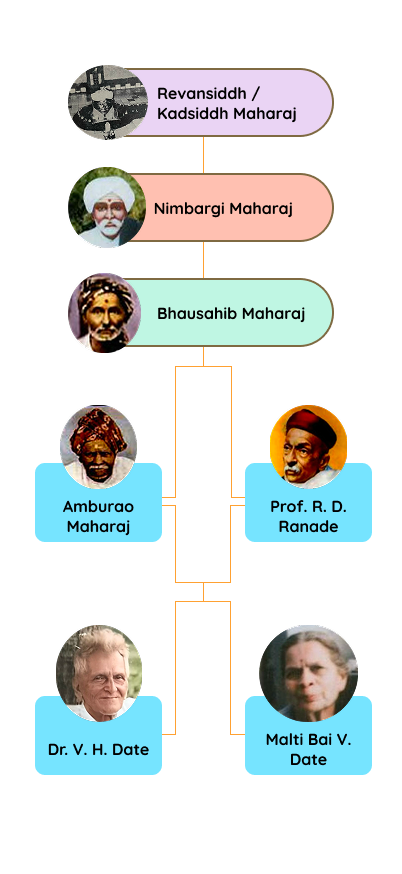
Spiritual Lineage
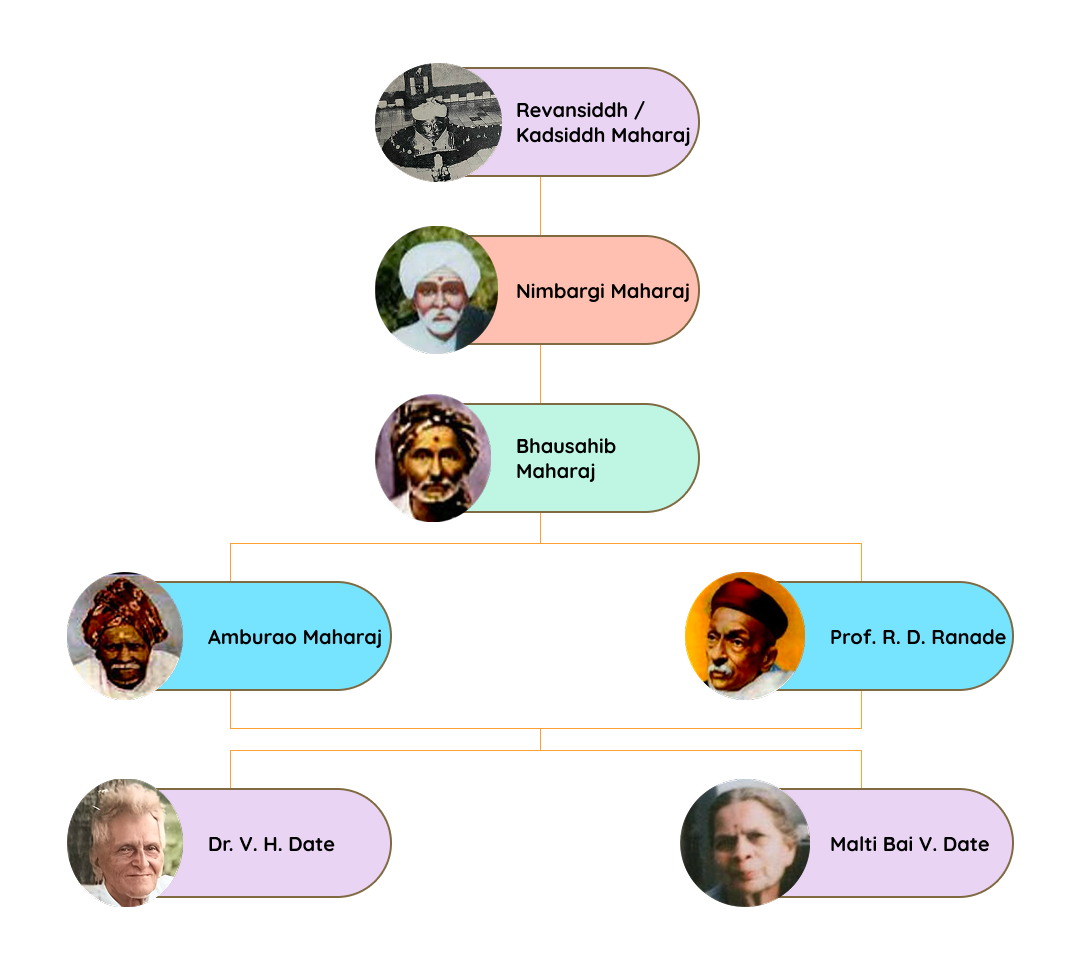
Sadguru Shri Nimbargi Maharaj
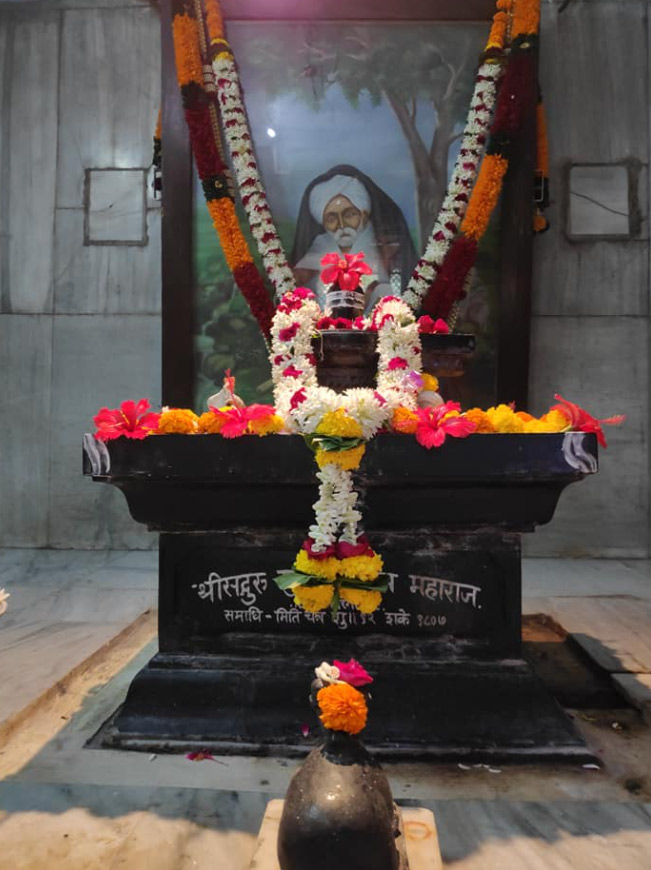
Samadhi of Sadguru Shri Nimbargi Maharaj at Devar Nimbargi
Also Known as Sadguru Shri Gurulingajangam Maharaj
Janma: Solapur, 9th April 1789 AD; Shake 1712
Anugrah: 1809-1814
Niryaan: 29th March 1885 AD; Chaitra Sh 12, Shake 1807
Shri Narayanrao Bhausahib, also known as Nimbargi Maharaj and Gurulingajangam, was the founder saint of the Nimbargi Sampradaya, a spiritual tradition rooted in deep meditation and devotion. Born in Solapur (Maharashtra) and raised in Devar Nimbargi village in Bijapur district (Karnataka), he belonged to the Lingayat community, sub-caste Neelawani, with the surname Misalkar.
As a youth, he was scolded by his father for participating in the Holi festival, which prompted him to leave home for Pandharpur, a renowned pilgrimage site. After intense prayer, Lord Vitthal appeared in his dream and directed him to Siddhagiri, where he met Muppinmuni, a yogi of the Kadasiddha lineage, who initiated him with a divine mantra and instructed him to meditate sincerely.
Although he initially neglected his spiritual duties for six years, a visit from his Guru rekindled his commitment. He gave up his profession as a dyer and became a shepherd to devote himself entirely to meditation. For the next 36 years, he practiced intense Naam Sadhana (meditative repetition of the divine name), achieving profound spiritual experiences and ultimately becoming a Sadguru.
For the final 28 years of his life, Nimbargi Maharaj guided disciples on the path of self-realization. He also interpreted Dasabodha by Saint Ramadasa, and his teachings were later compiled as “Bodh-Sudha” (The Nectar of Illumination). One of his key disciples was Raghunathpriya Sadhu Maharaj, who later guided Shri Venkatesh Khanderao Deshpande, known as Shri Sadguru Bhausahib Maharaj of Umdi, continuing the lineage.
Shri Nimbargi Maharaj passed away at the age of 95 on 29 March 1885, attaining spiritual union with the Divine. His Samadhi remains in Nimbargi Village, a site of pilgrimage and meditation for followers.
Gurudev Ranade praised him as a spiritually fragrant presence like the Bakula tree, while Swami Vivekananda’s words on unsung spiritual heroes are fittingly associated with him.
Sadguru Shri Bhausahib Maharaj
Sadguru Shri Bhausahib Maharaj (Umadikar) and the Nimbargi Sampradaya
Janma: Umadi, 1843; Chaitra Sh 9, Ramnavami, Shake 1765.
Anugrah: 1858.
Niryaan: Jan 29, 1914; Thursday, Magh, Sh 3 Shake 1835
Sadguru Shri Venkatesh Khanderao Deshpande, popularly known as Sadguru Shri Bhausahib Maharaj (Umadikar), was a prominent saint of the Nimbargi Sampradaya, founded by Sadguru Shri Nimbargi Maharaj.
Early Life and Devotion
Born in 1843 on Ramnavmi in Umadi village, Maharashtra, Venkatesh (Bhaurai) Deshpande was known for his intelligence and devotion. He worshipped Lord Hanuman at the Balbheem temple in Umadi, a holy and wish-fulfilling place. There, Shri Raghunathpriya Sadhu Maharaj (Sadhubua), disciple of Shri Nimbargi Maharaj, noticed his devotion and introduced him to the teachings of Nimbargi Maharaj.
At 14, Bhausahib Maharaj was initiated by Shri Nimbargi Maharaj and began meditating regularly on the divine name (Naam) given to him.
Spiritual Practice and Legacy
For 28 years, Bhausahib Maharaj meditated intensely daily, balancing spiritual practice with worldly duties. After Shri Nimbargi Maharaj’s passing, he intensified his meditation, achieving “Advaita Siddhi” — the highest realization of the self.
He conducted the Shravan Sadhan saptaha (spiritual gathering) at Umadi from 1885 to 1903, where many disciples joined for meditation sessions lasting from early morning till afternoon.
For 18 years thereafter, he meditated at night standing in a specially built two-foot space in his house, achieving supreme spiritual union. Bhausahib Maharaj became a revered Sadguru with many disciples and fulfilled his wish to build a Samadhi temple for his guru.
Spiritual Center at Inchgiri
Bhausahib Maharaj shifted the spiritual center to Inchgiri, where another Samadhi temple for Shri Nimbargi Maharaj was built. Following a divine message, he spread devotion across Maharashtra and Karnataka, traveling on horseback to places like Bijapur, Jamkhandi, and Solapur.
He passed away on 29th January 1914 at the age of 71, leaving behind a rich legacy of self-realization and spiritual teachings.
Teachings of Sadguru Bhausahib Maharaj
- Meditate on the divine name (Naam) given after initiation; it is the ultimate truth and path to soul illumination.
- Forgetting the Naam in daily life leads to illusion.
- A strong desire for self-knowledge is essential for spiritual progress.
- True devotion (Bhakti) requires dispassion towards worldly attachments.
- The root of the heart is the mind, where meditation should be focused.
Today, the Inchgiri temple complex houses the divine Samadhis of Sadguru Shri Nimbargi Maharaj, Sadguru Bhausahib Maharaj, and Sadguru Shri Amburao Maharaj.
Prominent disciples of Bhausahib Maharaj include Sadguru Shri Amburao Maharaj, Smt. Shivalingawwa Akka, and Sadguru Shri Gurudev Ranade.
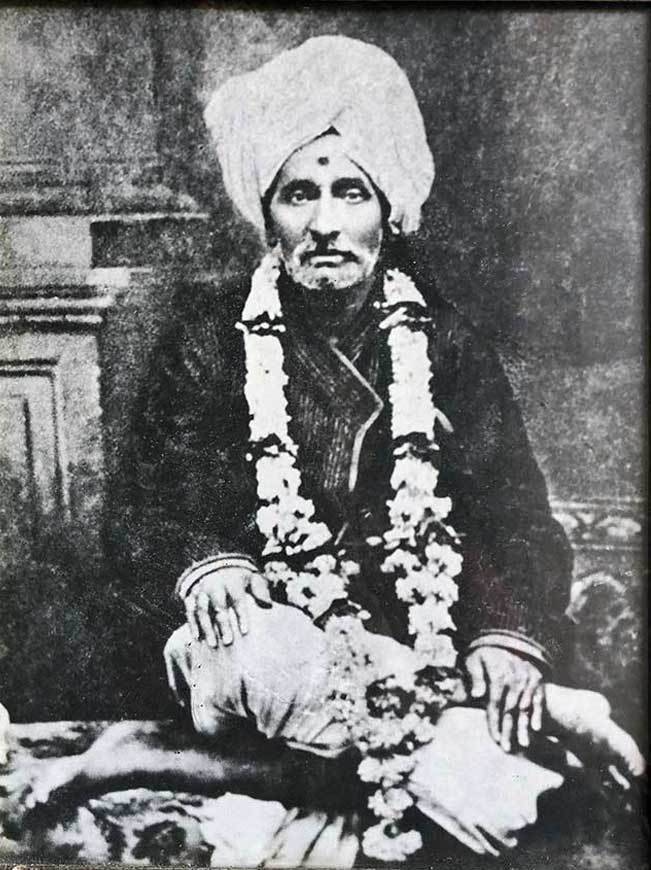
Shri Samartha Sadaguru Bhausahib Maharaj
Sadguru Shri Amburao Maharaj
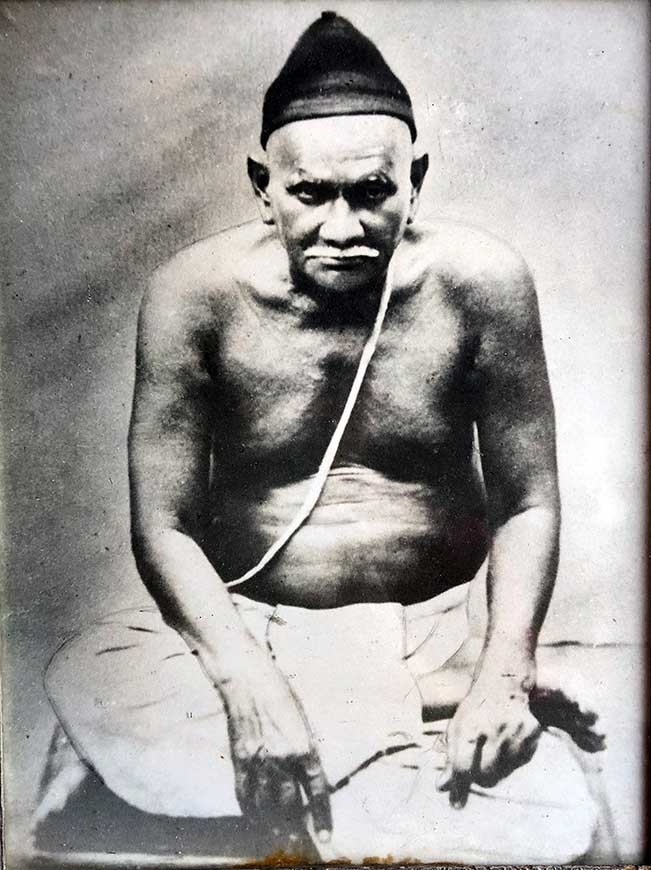
Sadguru Shri Amburao Maharaj
Direct disciple of H.H. Sadguru Shri Bhausahib Maharaj Umdikar.
Janma: Jigjivani, Sept 21, 1857; Monday, Bhadrapad Sh 9, Shake 1779
Anugrah: April 1892: Chaitra Sh 15, Shake 1814; 2 p.m.: in Siddheshar Temple
Niryaan Dec 22, 1933; Friday, Poush Sh 6, Shake 1855
Sadguru Shri Amburao Maharaj (Baba) – The Guiding Light of the Nimbargi Sampradaya
Sadguru Shri Amburao Maharaj, affectionately known as Baba, was a devoted disciple and spiritual guide who carried forward the legacy of Sadguru Shri Bhausahib Maharaj (Umadikar). Blessed with the divine Nama mantra by Bhausahib Maharaj, Baba’s intense meditation and devotion led him to become a siddha (awakened saint). After Bhausahib Maharaj’s passing, Amburao Maharaj became the protector and spiritual savior of many devotees, spreading Bhakti and initiating numerous disciples. He was also the guru-bandhu (spiritual brother) of Sadguru Shri Gurudev Ranade.
Brief Life Sketch
Born in 1857 in Jigjeevani into a poor Smarth Brahmin family, Baba faced many hardships early in life, including losing his parents and wife. His spiritual journey began after a visionary dream and the guidance of the saint of Umadi, Shri Bhausahib Maharaj. Initially hesitant, Baba accepted initiation through the mediation of Shri Bhaurao Savalsang and soon made remarkable progress in spirituality.
A notable incident reflects Baba’s humility and reverence when he questioned his guru’s authority to impart Nama but received a divine vision reaffirming his guru’s mandate.
Baba became a prominent spiritual teacher, with many educated disciples, including Prof. R. D. Ranade. Due to disagreements within the Sampradaya regarding leadership and initiation authority, Baba established an independent math at Inchgiri in 1927, while honoring his guru with a photo and maintaining his spiritual lineage.
Sadguru Shri Amburao Maharaj passed away on 22 December 1933 at Bijapur. His Samadhi is located beside that of his guru at Inchgiri. The math he founded was later renovated and continues to be a spiritual center.
Legacy
Sadguru Shri Amburao Maharaj is often compared to the 16th-century saint Kalyana Ramadasa for his spiritual stature and devotion. After his demise, Sadguru Shri Gurudev Ranade took up the mantle, initiating thousands, including aspirants from diverse religious backgrounds.
Rv. Smt. Shri Shivalingavva Akka
Direct disciple of H.H.Bhausahib Maharaj Umdikar (1867 AD – 1930 AD)
Smt. Shivalingavva Akka – The Mystic Saint of Jat
Smt. Shivalingavva Akka was a revered female mystic and an advanced disciple of Sadguru Shri Bhausahib Maharaj of Umadi. After the tragic loss of her son, she immersed herself deeply in spiritual practice with unwavering devotion. Through her dedication, she experienced profound mystical states and attained God-realization, fulfilling the highest purpose of human life.
Her spiritual stature is compared to great saintly women like Muktabai (sister of Saint Jnaneshwar) and Mirabai. Despite enduring many worldly sufferings, her faith in God and her Sadguru remained unshaken. With steadfast devotion and meditation, she blessed many disciples by initiating them with the sacred Nama mantra.
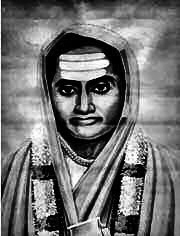
Rv. Smt. Shri Shivalingavva Akka
Sri Gurudev Dr. Ramchandra Dattatreya Ranade
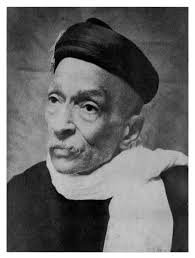
Sadguru Shri . Gurudev R. D. Ranade
A philosopher, a mystic and a SADGURU.
Janma: Jamkhindi, July 3, 1886;
Anugrah: 1901; Kartik Sh 14, Vaikuntha Chaturdashi
Niryaan: June 6, 1957; Thursday, Jeshth Sh 10, Gangadashami
India, often called Bharat, has always been a sacred land blessed with countless saints and sages whose spiritual Tapasya has made it a Punya Bhumi — a holy land. These saints have been the torchbearers of spirituality, spreading wisdom and awakening across centuries. Among the luminaries of modern India stands Sri Gurudev Dr. Ramchandra Dattatreya Ranade, a saint, philosopher, and scholar whose life was a radiant example of spiritual devotion combined with intellectual brilliance.
Early Life and Spiritual Initiation
Born on 3rd July 1886 at Jamkhandi in the Bijapur district, Dr. Ranade grew up in a devout household under the guidance of his pious mother. His early life was marked by a profound spiritual influence when he met Sadguru Shri Bhausahib Maharaj of Umadi. In 1901, he received the divine Nama initiation from Bhausahib Maharaj, which sowed the seeds for his lifelong spiritual journey.
Alongside his spiritual practices, Ranade excelled academically. His brilliance shone through school and college where he earned scholarships and gold medals. Yet, his quest was not merely academic; he sought intellectual justification for his spiritual experiences. This motivated him to study both Eastern and Western philosophy deeply.
Academic and Spiritual Journey
Dr. Ranade served as Professor of Philosophy at Fergusson College, Pune, and Willingdon College, Sangli, for about a decade. During this time, he faced severe illnesses which paradoxically deepened his spiritual insight and granted him rare experiences of bliss. Personal tragedies further intensified his devotion and practice.
In 1922, guided by a dream-vision, he settled in Nimbal, a small railway station between Solapur and Bijapur. There, he established a modest ashram which has since become a spiritual pilgrimage site.
Dr. Ranade was a prolific lecturer, delivering series on Upanishadic philosophy, the Bhagavad Gita, Vedanta, Hindi Mysticism, and Karnataka Mysticism at various centers across India. His lectures were later compiled into important philosophical and spiritual works, many published as books.
His first major publication, A Constructive Survey of Upanishadic Philosophy (1926), earned him international acclaim and led to his appointment at Allahabad University. There, he served as Professor and Head of the Philosophy Department, Dean of the Faculty of Arts, and eventually Vice Chancellor.
Spiritual Philosophy and Legacy
Sri Gurudev Ranade’s life was deeply God-centered — immersed in divine bliss and spiritual wisdom. He viewed the mystic as one who may or may not be a philosopher; however, a philosopher-mystic has the power to elevate humanity through both experience and intellect.
His dream was to create a comprehensive work on the Pathway to God, bridging Eastern and Western philosophies and religions. Although his untimely passing on 6th June 1957 prevented the completion of this project, his writings and teachings continue to inspire countless seekers.
Sri Gurudev Ranade’s spiritual influence radiated from two primary centers — North India, especially Allahabad, and South India at Nimbal. These places became confluences of spiritual streams that guided many souls toward the Divine.
